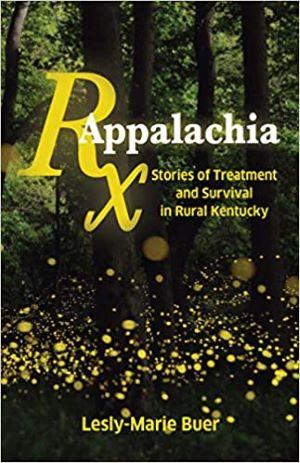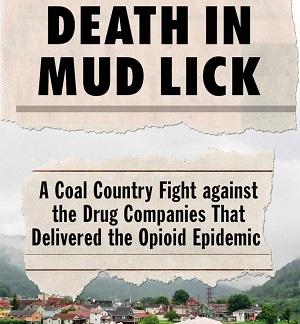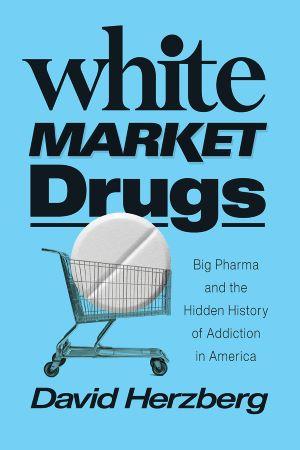RX Appalachia: Stories of Treatment and Survival in Rural Kentucky, by Lesly-Marie Buer (2020, Haymarket Books, 264 pp., $22.95 PB)
Death in Mud Lick: A Coal Country Fight Against the Drug Companies That Delivered the Opioid Epidemic, by Eric Eyre (2020, Scribner, 289 pp., $28.00 HB)
White Market Drugs: Big Pharma and the Hidden History of Addiction in America, by David Herzberg (2020, University of Chicago Press, 365 pp., $27.50 HB)
America remains in the grip of what is arguably its third great opioid addiction and overdose crisis. It began in the late 1990s as doctors tried to address an historic problem of under-prescribing and unavailability of opioids for chronic pain treatment that affected many patients. But mistakes were made along the way, and a massive tide of not always well targeted prescription opioids swamped the country. As regulators and law enforcement cracked down on pain pills, that morphed into a deadly wave of heroin addiction. And then we got fentanyl, which quickly took first place as a cause for overdose deaths. Produced mostly in China and Mexico, fentanyl is used by some hardcore addicts with high tolerance, but mainly appears as an adulterant added to heroin or in counterfeit prescription pills.

Taken together, the three books weave a damning indictment of pharmaceutical companies, the people and entities that are supposed to regulate them, and the moral crusaders who -- too often, successfully -- use the issue of drug use to call for repressive policies, especially aimed at people who aren't "good people;" that is, poor and/or non-white people.
There are also some things the books don't do more than tangentially. They don't touch on the issue of access to pain medications for chronic pain patients. These are people who often suffer not from too-easy access to prescription opioids, but from obstacles to access, and who have suffered even more as politicians and regulators moved to rein in what they argue is massive overprescribing of such medications.
Whether it's being prosecuted for seeking their medicine in the black market or being forced to jump through hoops to obtain their medicine or being refused it altogether in the white market, these are people whose access to the medicines they need is encumbered. Their story is an important part of the debate over opioids (and drug policy more generally), but it gets only a side mention in one of these three works. But over-prescribing of opioids and under-prescribing of them continue to coexist.
The books also don't attempt to disentangle supply-driven opioid abuse, from the so-called "deaths of despair." The same social and economic factors that have driven up the suicide rate in recent decades, and which arguably helped to elect Donald Trump, increase the rates at which drugs are used and abused, including opioids. That in turn leads to more overdose deaths, and some apparent overdoses actually are suicides.
And the authors don't ask their readers to question whether any given "pill mill" or seemingly too large prescription, is really what it looks like. If we accept that abuses in the supply system have played a role in the opioid crisis, that doesn't mean that any given doctor or pharmacist or distributor is guilty as charged. A medical practice with patients treating patients from hundreds of miles away, could be a "pill mill," but it could also have the one doctor who understands pain treatment and is willing to work with poor people whom other doctors view as too risky. A prescription that seems huge because of the number of pills, could represent diversion to the underground market – or it could mean that a long-term pain patient who needs a large dosage because of tolerance built up over time, and who doesn't use technology like a medically-inserted morphine pump, is reliant on pills and their standard-sized dosages that are designed for less tolerant patients. Without considering those contexts, pill numbers can be a misleading metric, at least some of the time.
The books do discuss some options for making effective opioid addiction treatments more easy for more patients to obtain, or for reducing the likelihood of a user coming to serious harm. But the most effective treatment for this type of addiction is the use of other opioids, in what's known as Medication Assisted Treatment (MAT). Through controlled use of methadone or buprenorphine supplied by clinics, people with opioid addictions are able to stabilize their lives and avoid catastrophic physical harms, while maintaining responsibilities like work and family needs. Making MAT available through a doctor's office, while training doctors in their use, would reduce the harm of opioid addiction by providing a legal alternative that works -- in this case a quality-controlled opioid. Offering HAT, too -- heroin assisted treatment, or heroin maintenance, as Canada and some European countries do for people who have tried methadone or buprenorphine without succeeding -- would do more.

All that said, there is an opioid crisis. These three books provide an eye-opening and important look at some critical sides of the phenomenon.
Lesly-Marie Buer is a Knoxville-based harm reductionist and medical anthropologist whose RX Appalachia is a compelling examination of the socially constructed suffering of mainly poor, white women who use drugs in a cluster of eastern Kentucky counties. She spent months living in the area, followed the women to court, to drug treatment, and opioid maintenance programs, and interviewed them extensively over time.
The result is a nuanced portrayal of these women's lives and struggles as they contend with the demands of institutions of social control even as they have to deal with poverty, child custody issues, and their stigmatization as drug users and therefore bad mothers. In that very important sense, RX Appalachia gives voice to the voiceless.
It also voices an unrelenting critique of a social and political system that provides unequal access to resources, chronically underfunds services to the poor and needy -- including but not limited to drug treatment and mental health services -- and is more willing to impose social controls on these women than to help them deal with the complexities of their lives. Appalachia RX is an important contribution to our understanding of the way drug policies, as well as broader social and economic trends, play out on the bodies of these multiply oppressed women.
How some of those women got strung out in the first place is the subject matter of Death in Mud Lick, still in Appalachia and just across the West Virginia line from those Kentucky women. Charleston Gazette-Mail reporter Eric Eyre won a Pulitzer Prize for his years of doggedly chasing down the story of how drug distribution companies pumped billions of opioid pain pills into the state in just a few years, and here, he puts that reporting in book form. It's quite a tale.
Eyre starts with a single drug overdose death, and by the time he's done, has unraveled a tangled tale of negligence, indifference, and profit-driven decision-making that left 1,728 West Virginians dead of drug overdoses in a six-year period. Thanks to Eyre's journalistic persistence and to a legal team determined to get to the bottom of the flood of pain pills that overwhelmed the state (and the region and the nation), we now know that drug companies dumped some 780 million hydrocodone and oxycodone tablets into the state during that same period.
There's plenty of blame to go around. Pharmaceutical corporations such as Purdue aggressively promoted their opioid products, doctors turned medical practices into pill-prescribing machines, pharmacies blithely filled numberless prescriptions, and drug distribution companies such as Cardinal and McKesson just as blithely delivered all those pills to the pharmacies, despite warning signs.
And regulators failed to regulate. Whether it was the state Board of Pharmacy or the DEA, regulators were asleep at the switch as an opioid epidemic grew right in front of them. And state officials were compromised by ties with the pharmaceutical industry and the distributors.
Eyre tells his tale with journalistic panache, taking the reader with him as he and his struggling newspaper take on the state political establishment and the distributors in the court battles that ultimately forced the companies and the DEA to release the records that documented the deluge of opioids. Death in Mud Lick is a real eye-opener.
But for David Hertzberg, an associate professor of history at the University of Buffalo and author of White Market Drugs, Eyre's story is just the latest chapter in the long history of America's effort to control drugs. Hertzberg begins with the opioid crisis of the late 19th Century and ably describes how the competing forces seeking to deal with it -- therapeutic reformers, repressive moral entrepreneurs, pharmaceutical companies, the medical profession -- created a class- and race-based bifurcation of the world of psychoactive substances into "medicines" and "drugs."
If it was prescribed by a physician, it was medicine. If not, not. The world of legal, regulated drugs became Hertzberg's white market. The world of repressed, prohibited drugs is the familiar black market. One serves middle-class white people and is concerned with consumer safety. The other serves the poor, the unconnected, the immigrant, the people of color, whose drug use and sales are considered crimes.
The history of drugs in America is well-trodden ground, but Hertzberg brings both new revelations and a new perspective to the subject. The drug reform movement's archvillain, Harry Anslinger, the master of Reefer Madness propaganda, becomes more than one-dimensional as Hertzberg tells the story of his strict scientific approach to opioids. As head of the Federal Bureau of Narcotics, Anslinger enlisted a Committee on Drug Addiction to closely study opioids, and those scientists even developed their own new opioids (they were market flops), as well as closely measuring the addictive potential of other potential new opioid products. Here, Anslinger was acting not as the heavy-handed lawman, but as the protector of white market consumers.

Given this history of pharmaceutical and regulatory fecklessness, Hertzberg comes to a shocking, but not really surprising conclusion: Left to their own devices, profit-drive drug companies peddling addictive products will function in ways that are incompatible with the public health. In Hertzberg's words:
"Profit-driven drug markets follow a predicably damaging cycle. Companies hype new medicines as safe and beneficial and sell with insufficient regard for consumer safety; a health crisis ensues as consumers are left ill-equipped to make informed decisions; authorities respond with consumer protections and destructive drug wars; the pharmaceutical industry devises strategies to circumvent the new restrictions and start the cycle again. After umpteen repetitions of this cat and mouse game, it may be time to acknowledge the impossibility of establishing a safe, for-profit market for addictive drugs. Alternatives exist: state monopolies, for example, or public utility models. We need to consider these and other creative ideas for dramatically minimizing or even eliminating profit from psychoactive capitalism."
Whether a shift to models of that type is what's needed, or just better regulation, is a question for debate. But it's clear that ending drug prohibition isn't enough. Reimagining the white market is necessary, too.
Add new comment